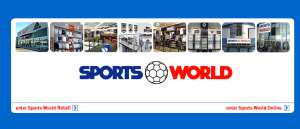Having a website that is little more than a splash page which offers visitors a choice of an online store or an instore-offers-website is a colossal mistake in web design.
This is a mistake that we’ve made at work, but have recently rectified.
This is also a mistake that quite alot of UK (newly-online) retailers make – especially our competitors.
This mistake in the wild

Take for instance Sports World, a customer finding themselves on www.sports-world.com is greeted with two options:
- enter sports world retail
- enter sports world online
As a potential customer my first question is, What’s the difference? If you’re making your customers ask this question your making them think and people don’t like to think on the web and won’t click either option or worse will click the wrong one and get frustrated by the result and not return.
Why this mistake is consistently made
You may find it strange that I would critique a competitors’ website for free but I can’t foresee them changing this situation so I feel safe. The reason for retailers using techniques such as this is pressure. Pressure from their high street stores who think the internet will steal their business and their jobs – and of course it will to a certain extent but, according to an article on https://www.dropshiplifestyle.com/cheap-shipping/, that’s going to happen anyway so why fight it?
If XYZ Shoes refuse to create an ecommerce site for fear of upsetting their store managers then ABC Shoes will simply control all the online shoe market with their website and they’ll probably bid on the keyword XYZ Shoes on Adwords.
How to fix it
At JJB I’ve recently removed this awkward feature – although ours was slightly different – for various reasons our store locator and a competitions data-collecting feature needed to be on a separate server and therefore a different designed website that had different goals but having this separate website must’ve seemed ludicrous to an outside observer.
Removing yourself from the pressures of people above and around you and looking at your website from the perspective of a customer can be hugely rewarding. Doing this allows you to see the site not from the perspective of a politik but from someone actually spending money and it makes you see where and when you’re made to think or led to confusion by your own website.
Disclaimer: Putting yourself in someone else’s shoes is not a complete alternative to usability testing with real people.
Nice site!